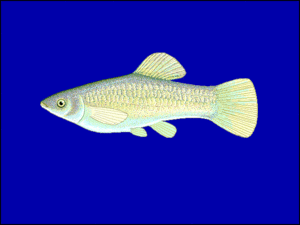Amazon molly facts for kids
The Amazon molly (Poecilia formosa) is a special kind of freshwater fish. It lives in warm rivers and streams in places like northeastern Mexico and southern Texas in the United States. What makes this fish so unique is how it has babies! Almost all Amazon mollies are females. They reproduce in a very unusual way, which we'll learn more about. The name "Amazon molly" comes from the Amazons, who were legendary female warriors in Greek mythology.
Quick facts for kids Amazon molly |
|
|---|---|
 |
|
| Conservation status | |
| Scientific classification | |
| Synonyms | |
|
How Amazon Mollies Reproduce
The Amazon molly reproduces in a very special way called gynogenesis. This means that female fish can have babies without needing a male's genes. Even though they need a male fish to start the process, the male's sperm does not mix with the mother's egg. It only triggers the egg to start developing.
Because of this, the babies are exact copies, or "clones," of their mother. This is why the Amazon molly is an all-female species. Other animals that reproduce this way include the New Mexico whiptail lizard and the Blue-spotted salamander.
Mating with Other Fish
In nature, Amazon mollies usually mate with males from other closely related fish species. These can be males from species like P. latipinna, P. mexicana, or P. latipunctata. Sometimes, they might also mate with P. sphenops males.
You might wonder why male fish would help the Amazon molly reproduce if their genes aren't passed on. Scientists think that mating with Amazon mollies might make these males more attractive to females of their own species. So, Amazon mollies can only live in places where these other male fish are also present.
Life Cycle and Growth
Amazon mollies become ready to have babies when they are between one and six months old. A female can have a group of 60 to 100 young fish, called "fry," about every 30 to 40 days. This means their population can grow very quickly if there are enough male "host" fish around.
How fast they grow and how many babies they have depends on a few things. These include their genes, the water temperature, and how much food is available. They grow faster and have more babies in warm water (around 27°C or 80°F) where there is plenty of food.
Amazon mollies have been reproducing without a male's genes for a very long time. Scientists estimate it's been about 100,000 to 200,000 years. This is a huge number of generations for a species that reproduces asexually. Researchers are still studying how these fish have managed to survive for so long without the genetic mixing that usually comes from two parents.
See also
 In Spanish: Poecilia formosa para niños
In Spanish: Poecilia formosa para niños


